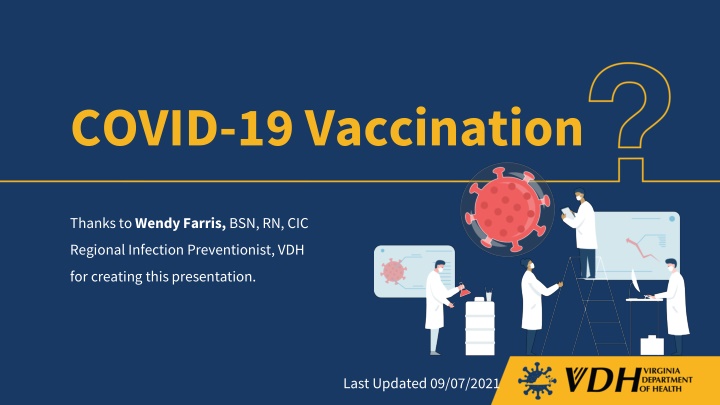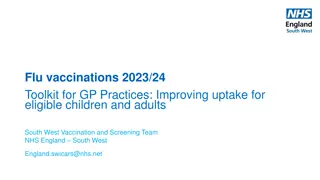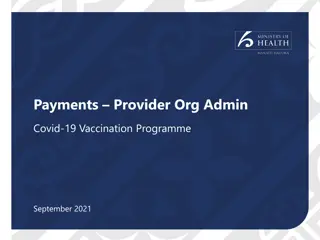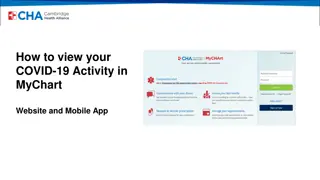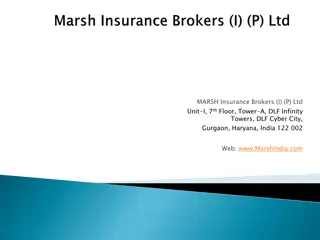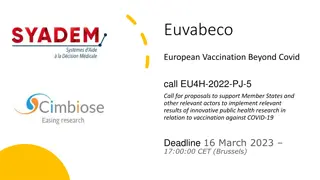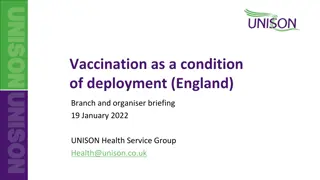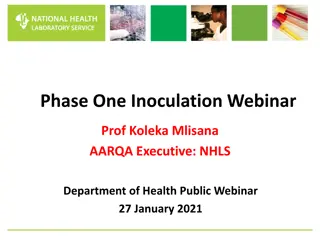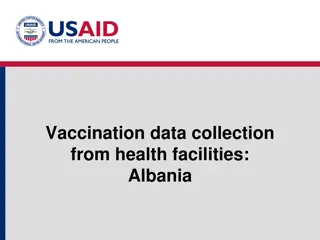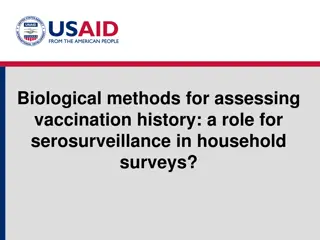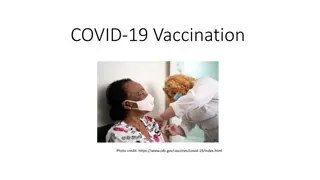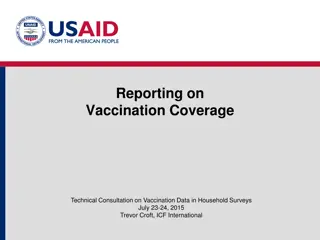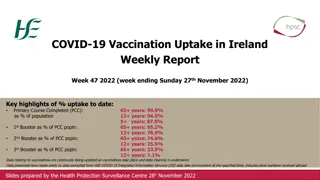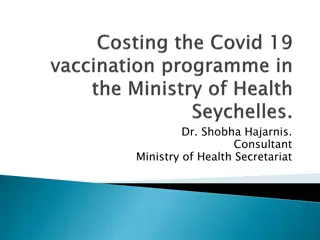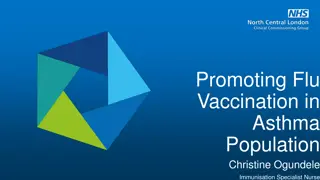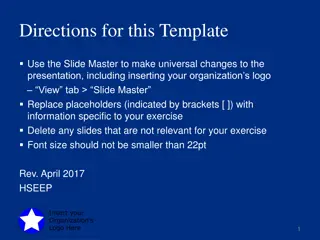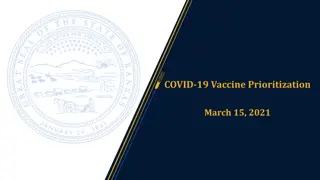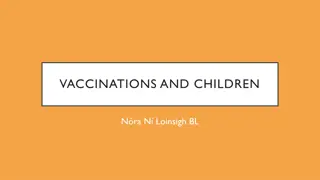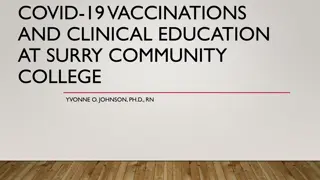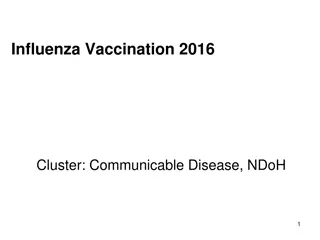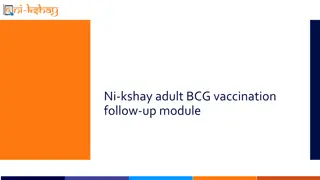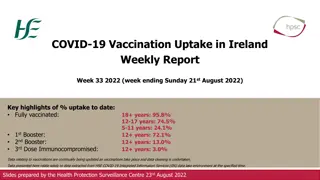COVID-19 Vaccination
Dive into the latest COVID-19 vaccination information presented by Wendy Farris, BSN, RN, CIC, a Regional Infection Preventionist for VDH. Stay informed with this comprehensive update as of 09/07/2021.
Download Presentation

Please find below an Image/Link to download the presentation.
The content on the website is provided AS IS for your information and personal use only. It may not be sold, licensed, or shared on other websites without obtaining consent from the author.If you encounter any issues during the download, it is possible that the publisher has removed the file from their server.
You are allowed to download the files provided on this website for personal or commercial use, subject to the condition that they are used lawfully. All files are the property of their respective owners.
The content on the website is provided AS IS for your information and personal use only. It may not be sold, licensed, or shared on other websites without obtaining consent from the author.
E N D
Presentation Transcript
COVID-19 Vaccination Thanks to Wendy Farris, BSN, RN, CIC Regional Infection Preventionist, VDH for creating this presentation. Last Updated 09/07/2021
Purpose Provide accurate information regarding COVID-19 vaccine Dispel myths and share knowledge Arm you with facts so you can make informed decisions Provide you with necessary information to educate yourself and your staff members about COVID-19 vaccines
A vaccine is like training for a marathon Could you run 26.2 miles without training? You might be able to finish, but you would probably be miserable and run the risk of hurting yourself, maybe even seriously enough to need medical care. A vaccine is like training for a marathon. It has your body do all the same things it would do for a real infection without the risk of actually being sick. It trains your immune system and prepares your body to go the full distance. So when it is actually go time and you are exposed to the virus, your body has its best chance to minimize the risk or completely avoid sickness.
Vaccine Types Pfizer and Moderna vaccines are mRNA vaccines. Various companies have tried to make mRNA vaccines over the last 5 years (mostly for Ebola, Zika, rabies and HIV, but also for cancer and allergies). These are the first mRNA vaccines approved by the FDA. The biotechnology has never been approved by the FDA before, NOT because the past mRNA vaccines have been deemed unsafe, but because past mRNA vaccines haven t been very effective.One of the main issues has been figuring out a way to get the vaccine to the cells effectively. mRNA breaks down VERY quickly, so it needs to be transported by something. Finding that something has been a challenge. The current vaccine uses a fat bubble (lipid nanoparticles) which has worked well. mRNA is like a recipe card that tells your body how to recognize the spike protein and defend itself against COVID. The spike protein created by the vaccine is not the same as the SARS- CoV-2 spike protein. It has been modified to be harmless.
Vaccine Types The Janssen/Johnson and Johnson (J&J) vaccine is a viral vector vaccine that uses a harmless virus (known as the vector) to enter the body and then uses the cell s machinery to producea harmless piece of the virus that causes COVID-19. Protection from the vaccine is stronger than the protection from the infection. Experts don t know how long the advantage of protection from infection will last, or if it works against new variants. All three vaccines (Pfizer, Moderna, & J&J) reduce the risk of getting COVID-19. More importantly, clinical trials proved that the vaccine is safe and works well to prevent severe illness, hospitalization, and death.
Adverse Events Vaccine Adverse Events Reporting System-VAERS VAERS is a national vaccine safety surveillance program that is co-sponsored by the CDC and FDA. The purpose of this program is to detect possible signs of an adverse event associated with vaccines. A report can be made by any individual - a patient, a parent, health care worker, or vaccine manufacturer. VAERS does not determine if a vaccine caused or contributed to an adverse event. It is a monitoring system that acts as an early warning for the CDC and FDA. VAERS relies on people reporting their experience after vaccination. This reporting system is used to monitor safety of new vaccines, detect new, unusual or rare adverse events, monitor known side effects (e.g., injection site pain), identify clusters, and watch for patterns. If a pattern is detected then further follow up is performed by the CDC.
Adverse Events-continued J&J Vaccine As of June 14, 2021, more than 11.7 million doses of the J&J vaccine had been administered in the US. There were 36 confirmed reports of people who suffered thrombosis with thrombocytopenia syndrome (involves blood clots and low platelets) after receiving the vaccine. The condition is serious, but with early recognition of symptoms, it is treatable. The use of J&J vaccine has a warning that women younger than 50 years old should especially be aware of this rare adverse event and may wish to choose another vaccine option. This same type of occurrence was not shown in the Pfizer or Moderna vaccine trials or in the real world (United States-97 million doses of Pfizer and 84 million doses of Moderna in arms). https://www.cdc.gov/coronavirus/2019-ncov/vaccines/safety/JJUpdate.html
Adverse Events-continued mRNA Vaccines Since April 2021, there has been an increased number of reports to VAERS of cases of myocarditis (inflammation of the heart muscle). The reports are rare given the number of vaccines given but has been noted particularly in adolescents and young males with a higher occurrence following the 2nd dose. Most cases responded to treatment and were self limiting. Some did have more serious disease so not risk free but very low risk. (Females: 4.7 cases per million after the second dose; Males: 32 cases per million after the second dose; estimated 12-39 age range) Occurs typically several days after the vaccine was given The Advisory Committee on Immunization Practices (ACIP: group of medical and public health experts who develop recommendations on vaccines for the US) released their findings and feel the risk of myocarditis is outweighed by the benefit of the vaccine.
Myocarditis Myocarditis has occurred after COVID infection and has been part of a study done on athletes who showed inflammation in the heart, some without symptoms. The takeaway is that the combined risk of Multisystem Inflammatory Syndrome in children, long COVID and severe covid symptoms outweigh the risk of myocarditis. The vaccine is still recommended. Symptoms to look for are chest pain, SOB, fluttering or pounding heart sensation.
Vaccination Importance Each person who becomes ill with COVID-19 has the potential to change the virus slightly (this is called mutation). Mutation typically occurs in favor of the virus to increase its survival rate. The more virusspreads in the community, the higher the chance of mutation as it spreads from person to person and the higher the risk for significant change to the virus. Public health concern is that through mutation, the virus may become a new strand unrecognized by our immune system. We could once again be at risk for wide-spread disease and death. CDC has named the Delta variant first discovered in India as the new bad guy in the COVID fight. First recognized in the US in March 2021, it has shown a hyper transmissible ability (64% more contagious and 85% more likely to cause hospitalizations) and has become the dominant variant seen in the US. It is also of concern as we return to life as normal. So far, our vaccines have shown effectiveness against the Delta strand.
Vaccination Importance Herd immunity is needed to protect the greater community but COVID may not go away, and we will see seasonal surges with the risk of becoming critically ill still present, or the risk to transmit to someone else who may become critically ill. You play a crucial role in stopping the spread and mutation of COVID; the FIGHT is not over.
Myth -The vaccine was created too quickly Previous Research COVID-19 is roughly related 80% to SARS. In 2003, work began on a vaccine that would recognize the SARS spike and was moving toward clinical trials. Those trials never really proceeded because SARS did not develop as originally thought to become a world-wide disease, which caused money for funding to dry up. When COVID became a world-wide disease, we were not starting from scratch, but instead used the groundwork of the SARS vaccine, which was the key in getting the vaccine trials up and running.
Money and Resources NEVER, EVER in the history of public health has this much money and resources been aimed at one disease at one time Typically, money must be applied for through grants which involve multiple layers of hoop jumping and phases of applications In an emergency response to a world-wide health crisis, no grants were required and monetary support poured in from multiple sources (including emergency funds from Congress) with the single focus of creating a vaccine.
High Level of Disease The FDA specifies before trials begin what efficacy threshold must be set for emergency use. For COVID, that effectiveness threshold was set at a rate of higher than 50%. An emergency use authorization was given which basically says we have nothing out there to help in this disease and a vaccine was the best hope of combating the pandemic. Due to the high levels of COVID in our communities, it actually made the vaccine easier to create. More virus actually allowed testing of the effectiveness of the vaccine to occur quickly. Many disease trials drag on as researchers wait for enough infected people to be a comparison group. For example, 162 people are needed to get COVID, so they can compare how many of the 162 were in the vaccine group versus placebo group. So those thresholds were quickly met.
Production Sponsors were starting to produce the vaccine while the vaccine was in trials, which is very unusual, but this occurred because governments around the globe were willing to look at this as risk vs. rewards. This shaved off a ton of time as vaccine sponsors could work out the manufacturing kinks and anticipate needs for production.
Overlapping Phases Due to the emergent nature and spread of COVID, a strategy known as seamless and adaptive design was used. This means each phase of the vaccine trials overlapped and removed a lot of the dead space associated with trials. For example, phase 2 dose selectionis combined with phase 3, which is confirmation of the dose to create one phase instead of two. This method of trials has been used before COVID for drugs that show great promise (example: a metastatic melanoma medication allowed the drugs to be in use for patients much quicker than the typical phases).
Enrollment In drug trials, it can be difficult to find volunteers to enroll for studies. One researcher said that his current trial goal is to enroll 240 people in two years. For the COVID-19 trials, the amount of people who volunteered was astounding and with their willingness, the vaccine process was quicker than ever.
Bottom Line Leveraging the world s most intelligent minds + Supply of ample money, facilities + Utilizing previous years of work on multiple other vaccines, and studies are already completed = Speed but not rushed vaccine
In God we trust. All others must bring data Quote by American Statistician W. Edward Demning The world today is full of fast, immediate and often misinformation. Words of Warning: check the source. False authority is using your alleged authority (or title) as evidence that what you say is true. We saw this often in the media when someone who stated they were a doctor and gave false or inaccurate information. Remember the title of doctor, scientist, or researcher can be true but the area of expertise must also align with the information they share. A dentist should not be considered the expert on how to treat your hypertension.
In God we trust. All others must bring data What makes someone an expert? Experience + Training + Access to current Information + Unbiased + Knowledge = EXPERT Their claim is relevant to their field of expertise and supported by evidence How did they obtain their information (data) and how did they reach this conclusion? Did the method they use support their findings? Cherry Picking Non-experts often resort to only using portions of data that supports their narrative and cite it as proof, completely ignoring the data that do not support their views.
Facts SARS-COV-2 is a novel member of the coronavirus family Scientist and doctors have been slowly learning and further understanding it. It can only be done through obtaining data, analysis and interpretations. It is time consuming and changes as new evidence is presented Be wary of who you receive information from. Know who the source is. Are there other reputable sources who share this information? One study, even if done correctly, isn t proof. Rather a whole body of evidence is needed to tip the scales in one direction. Bottom line: Don t believe everything you hear on social media or the news. Research and find your truth.
Rumors and Myths RUMOR - Vaccine makers are immune from liability in the US Yes, this is true for all vaccines (not just COVID) but there is a system of compensation for someone who may have a vaccine reaction (in place prior to COVID). Why does this exist? To encourage companies to research and develop non-money maker needed drugs for the good of the community. MYTH -Vaccine companies are not to be trusted There is a system of checks and balance present in a complete separate monitoring board called DSMB (data safety and monitoring board) for every study, not just vaccines, external scientific monitoring board-FDA and the Advisory Committee of Immunization Practices of the CDC. During the COVID trials the DSMB announced that they had notified AstraZeneca that it was concerned with information on their initial vaccine trial. The data submitted may have included outdated information and not given a true picture of the vaccines effectiveness. This was then submitted to the FDA and CDC.
RUMOR -No data on duration of protection from COVID Based on the available data, It is not yet known how long protection from the vaccines will last or if people will need boosters (additional vaccines). Science is evolving and the health experts are closely monitoring the data to determine how long the protection lasts. MYTH - The vaccines do not stop transmission or infection Numerous studies have shown that the vaccines do stop transmission. However, the question is how much does it stop; the current rate is between 70-95%. MYTH - People are catching COVID after being fully vaccinated Yes, this is true. What I have personally seen is that this seems to occur more frequently in the elderly and the immunocompromised. Why? As we age, our immune response lessens so antibody production maybe less. However, those who have tested positive, the clinical course seems to be milder; this may be because they are less infectious due to lower viral loads, but further studies are needed and are currently occurring. With Delta, the viral loads are higher which not only causes easier transmission to unvaccinated individuals, but also a possibility of more breakthrough infections in the vaccinated.
MYTH - Death rate from COVID is exaggerated COVID-19 was the 3rd leading cause of death in 2020 (heart disease and cancer were 1st and 2nd, respectively). We lost over 3.5 million people to COVID-19 worldwide. Data show significant excess death rates globally especially in countries with uncontrolled spread. THESE DEATHS WERE REAL AND WERE DUE TO COVID-19. MYTH - 99% of reported COVID deaths are inaccurate That is not true and is based on demographics of the group. Younger people will have a lower death rate, but is still an increase in deaths. The percentage does increase with age and we still do not know the long range rate of deaths that are COVID related. For example, lung damage from COVID could cause a death many years after the illness or be a contributing factor (lung damage but then develop a pneumonia which they cannot recover from).
Death isnt the only outcome. COVID affects all body systems. Lungs: lose the ability to pass oxygen to the blood and remove carbon dioxide. The type of pneumonia associated with COVID can cause long standing damage to the lungs with resulting scar tissue, which can lead to long term breathing problems. Heart: 20-30% of COVID patients develop heart damage even in people who experienced only mild COVID symptoms Nervous system/brain: 33% of patients experience COVID-19 fog. Even in young people, COVID-19 can cause strokes, seizures and Guillain Barre syndrome. MS like symptoms including tingling, numbness and weakness. 10% have long term smell and taste issues, concentration and memory problems Kidneys: 78% of critical ill develop kidney injury Skin: rashes and hair loss Digestive system: 17% develop pancreatic damage leading to chronic disease Blood: COVID can cause blood clots and some of the heart damage is believed to be small clots blocking multiple small vessels Psychological/mental health issues: some of this could be due to PTSD from surviving a severe illness
Multisystem Inflammatory Syndrome in Children (MIS-C) Associated with Coronavirus Disease Multisystem inflammatory syndrome in children (MIS-C) is a condition where different body parts can become inflamed, including the heart, lungs, kidneys, brain, skin, eyes, or gastrointestinal organs. We do not yet know what causes MIS- C. However, we know that many children with MIS-C had the virus that causes COVID-19, or had been around someone with COVID-19. MIS-C can be serious, even deadly, but most children who were diagnosed with this condition have gotten better with medical care. Most children who become ill with MIS-C will need to be treated in the hospital. Some will need to be treated in the pediatric intensive care unit (ICU). Children with MIS-C may have a fever and various symptoms, including abdominal (gut) pain, vomiting, diarrhea, neck pain, rash, bloodshot eyes, or feeling extra tired. https://covid.cdc.gov/covid-data-tracker/#mis-national-surveillance
Long COVID Some patients who have been infected with SARS COV-2 have new, recurring or ongoing symptoms and other clinical findings more than 4 weeks after their original infection.Symptoms range from mild to severe. Norwegian study 312 patientswere studied, of which 247 had mild/moderate COVID cases vs. 65 severe COVID cases. 61% (189/312)of all COVID patients showed persistent symptoms 6 months after their initial infection (all age groups, all disease severity levels) 52% (32/61)of young patients (age 16-30 years) show persistent symptoms after mild to moderate initial COVID disease
Long COVID Long COVID describes long-term effects of the infection, including symptoms that can last for weeks or months after being infected with the COVID-19 virus. 28% had disturbed sense of taste and or smell 21% fatigue 13% shortness of breath 13% impaired concentration 11% memory problems Children and teens were the affected least often
Pregnancy The Vsafe Pregnancy Registry is the voluntary reporting system for pregnant women who have received the COVID-19 vaccine either 30 days before conception or during their pregnancy. As of June 14, 2021, 124,597 women indicated they were pregnant at the time they received their vaccine. Of those, 5,102 are currently enrolled in the registry and are being followed long term. Information gathered from the Vsafe Registry, the Vsafe Pregnancy Registry and the Vaccine Adverse Event Reporting System (VAERS) collected from December 2020 - Feb 20, 2021 revealed that the rate of miscarriages, preterm births and birth defects in vaccinated women were seen as comparable to those unvaccinated. This is an ongoing project with further studies and follow up occurring.
Pregnancy So far pregnant women with the vaccine had the same side effects as non pregnant women with injection site pain reported slightly higher in pregnancy but lower complaints of headache, body aches and fever post vaccine. No unexpected pregnancy or infant outcomes have been observed related to the vaccine during pregnancy
References https://yourlocalepidemiologist.substack.com/p/az-and-nih-disagree https://camargopharma.com/resources/blog/seamless-clinical-trials/ https://bmcmedicine.biomedcentral.com/articles/10.1186/s12916-018-1017-7 https://www.bmj.com/content/370/bmj.m2426 https://www.medscape.com/viewarticle/938683_4 https://www.ersnet.org/the-society/news/covid-19-patients-suffer-long-term-lung-and- heart-damage-but-it-can-improve-with-time https://bmcpulmmed.biomedcentral.com/articles/10.1186/s12890-020-01286-5 https://www.ajronline.org/doi/pdf/10.2214/AJR.20.23034 https://www.nature.com/articles/d41586-020-02598-6#ref-CR1 https://radiologyassistant.nl/chest/covid-19/covid19-imaging-findings
References https://www.cdc.gov/coronavirus/2019-ncov/index.html https://www.fda.gov/emergency-preparedness-and-response/coronavirus-disease-2019- covid-19/covid-19-vaccines https://www.nature.com/articles/s41591-021-01433-3 https://papers.ssrn.com/sol3/papers.cfm?abstract_id=3790399 https://www.medrxiv.org/content/10.1101/2021.02.15.21251623v3 https://pubmed.ncbi.nlm.nih.gov/33900384/ https://www.cdc.gov/mmwr/volumes/70/wr/mm7034e2.htm https://www.cdc.gov/mmwr/volumes/70/wr/mm7013e3.htm https://www.nejm.org/doi/full/10.1056/nejmoa2101765 https://www.authorea.com/users/332778/articles/509881-single-dose-bnt162b2-vaccine- protects-against-asymptomatic-sars-cov-2-infection
Heart: https://jamanetwork.com/journals/jamacardiology/fullarticle/2769182 https://jamanetwork.com/journals/jamacardiology/fullarticle/2768916 https://www.heartrhythmjournal.com/article/S1547-5271(20)30625-1/fulltex t Nervous system: https://academic.oup.com/brain/advance-article/doi/10.1093/brain/awaa240/5868408 https://www.acpjournals.org/doi/10.7326/L20-0845 https://jamanetwork.com/journals/jama/fullarticle/2768351 https://els-jbs-prod- cdn.jbs.elsevierhealth.com/pb/assets/raw/Health%20Advance/journals/jmcp/jmcp_ft95_5_18.pdf https://www.acpjournals.org/doi/10.7326/L20-0845 https://cp.neurology.org/content/early/2020/06/30/CPJ.0000000000000897 Kidney: https://www.bmj.com/content/369/bmj.m1996 www.hopkinsmedicine.org/health/conditions-and-diseases/coronavirus/coronavirus-kidney- damage-caused-by-covid19%3famp=true
Digestive System: https://www.cghjournal.org/article/S1542-3565(20)30646-7/pdf https://www.ncbi.nlm.nih.gov/pmc/articles/PMC7194639/https://www.biorxiv.org/conten t/10.1101/2020.04.14.040204v1.abstract Skin: https://www.aad.org/public/diseases/hair-loss/causes/covid-19 Blood: https://www.thelancet.com/journals/eclinm/article/PIIS2589-5370(20)30178-4/fulltext https://www.cdc.gov/coronavirus/2019-ncov/vaccines/different- vaccines/mRNA.html?s_cid=10506:rna%20vaccine:sem.ga:p:RG:GM:gen:PTN:FY21 https://www.fda.gov/vaccines-blood-biologics/vaccines/emergency-use-authorization- vaccines-explained @sciencewhizliz
